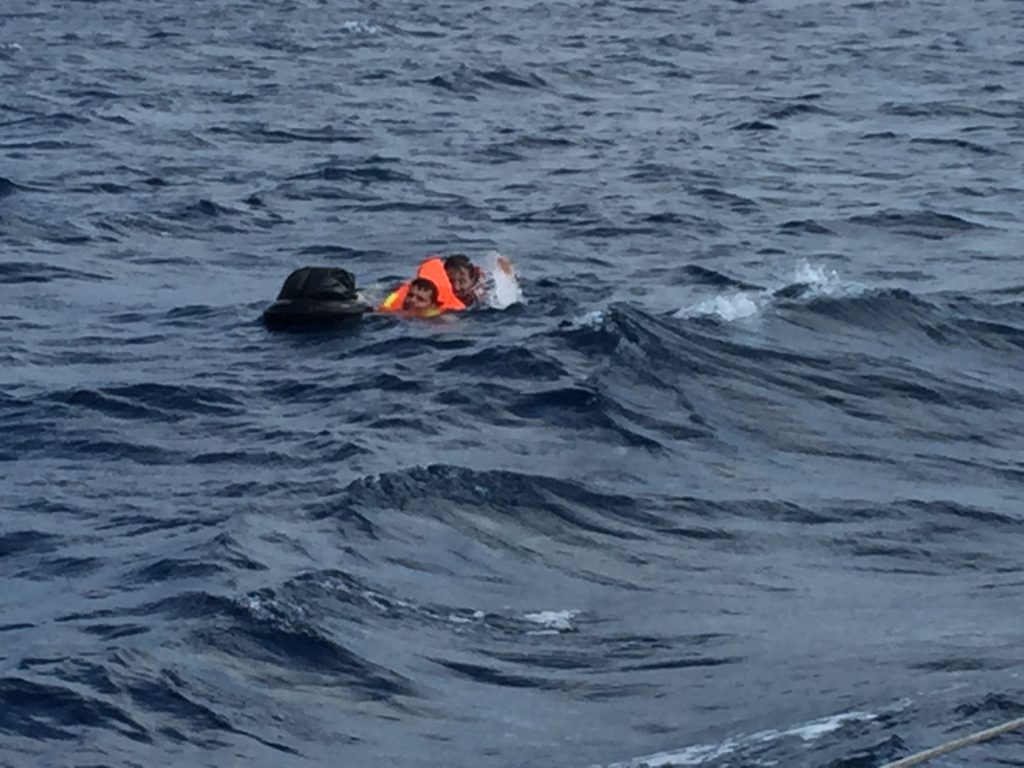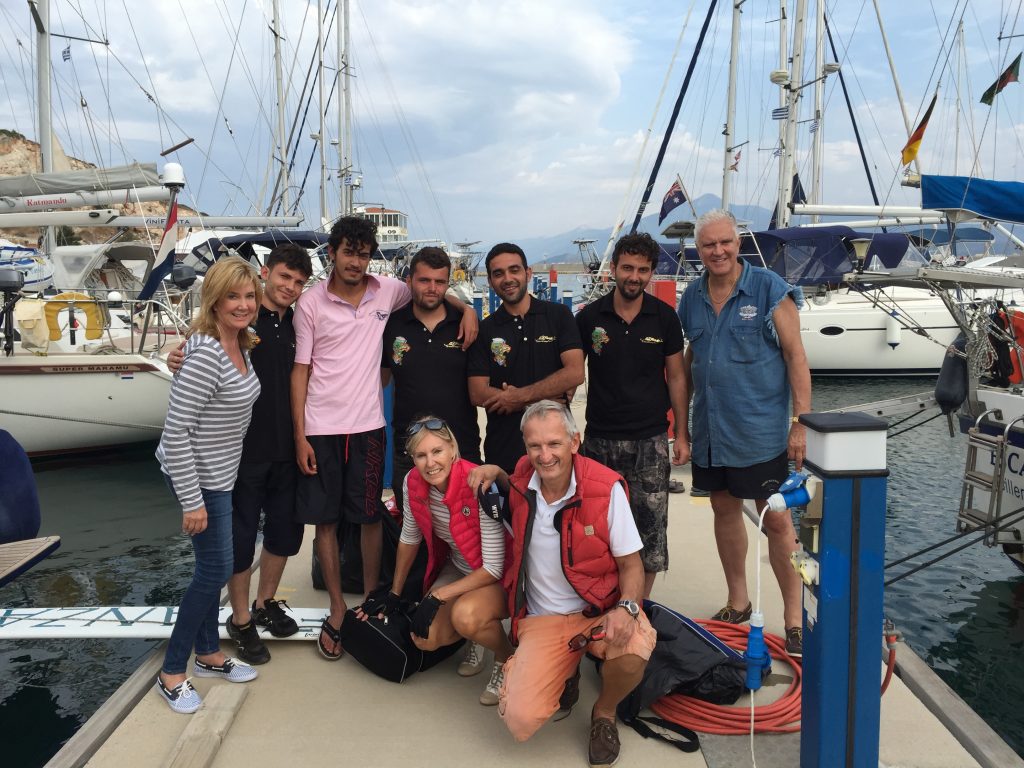After spending a hectic time lecturing at the Austrian Aesthetic and Reconstructive Plastic Surgery Meeting in Salzburg, Austria, Orange County, California plastic surgeon Juris Bunkis, MD, and his wife Tina, were excited to take a relaxing cruise with course President Dr. Walther Jungwirth. Dr. Bunkis and Dr. Jungwirth were old friends. Dr. Jungwirth trained under Dr. Bunkis in the mid-1980’s while Dr. Bunkis was at USCF (University of Southern California San Francisco), and the two have kept in touch ever since. Dr. Jungwirth had invited Dr. Bunkis and his wife Tina to travel with him and his wife to Kusadasi, Turkey where he keeps his 50 ft carbon yacht (Fidanzata) moored, with the intent of spending one week together sailing the southern Greek isles, namely Samos and Patmos. What happened next can only be called a “Hero’s Story”. The group went on to risk their own lives to save the lives of 5 refugees they found freezing to death and exhausted in the Aegean Sea between Turkey and Greece and bringing them to safety. Aesthetic Insider™ News sat down with Dr. Bunkis to learn first-hand the full details of this incredible rescue.
How did you first spot the refugees in the water?
We were in the narrow straight between Samos and Turkey when we spotted people in the water. In this straight, the currents and winds are fairly strong. I was at the helm and Tina was on the front deck. It was Tina who spotted the first person. He was dressed in black, and was wearing a dark life vest. He was clutching a small inner tube that carried a plastic garbage bag with all his worldly possessions. He was hard to see and once we spotted him swimming, it was too late to stop and we missed him by about 20 feet. As we spotted him, we saw a larger motor boat about one hundred yards in front of us. The crew was pulling two people out of the water. We thought they were the Coast Guard and headed towards them to let them know about the swimmer we had just passed. As we got closer, however, the driver started his engines and took off to the south – we could see then that it was not a Coast Guard cutter. We carefully dropped our sail and went back to pick up the person we had seen. With some effort, we pulled him out of the water and discovered that he was Syrian and a refugee. He had been in the water for seven hours, was frozen and exhausted, thirsty and starved. He had entered the Aegean Sea that morning before dawn with six other refugees. Within the next thirty minutes we spotted four others from the group and were able to pull them to safety. Two of them did not know how to swim! All of them spoke fairly good English but they were all exhausted and had hypothermia. I doubt that they would have made it to the shore alive.
What was the first thought that came to mind when you saw them?
They were human beings and would have perished had we left them in the water – rescuing them was the only humane thing to do. We reacted quickly with the only thought of bringing them to safety. Once we had all five of them on board, however, Walther and I, and our wives, did feel a little apprehensive about possible violence but these thoughts were unfounded, the young gentlemen were polite, grateful and no threat to us at all.
What was your wife’s reaction?
The same as all of us from a humanitarian point of view, we agreed with rescuing them, but were a little apprehensive at first as five young men came aboard. Tina is a very caring person and as soon as they came aboard, she gave them towels, blankets and coats while we fed them and gave them water. By the time we got to shore, Walther gave each of them a polo shirt with his ship’s logo from a regatta he had entered previously. He also gave each of them 20 Euros.
How did you go about performing the rescue?
When we saw them, we lowered the sails and used the engine to maneuver the yacht. Walther steered the boat upwind from the refugees in the water and let it drift backwards towards the men. I stood on the platform at the back of the yacht, threw the swimmers a rope and pulled them up to the platform and then pulled them out of the water. I helped each person up over the rail onto the deck where we immediately wrapped them in towels and blankets as we knew they were freezing.
Did you have any fears about the potential consequences such as violence or pirating on the part of the refugees, or trouble with the law for aiding refugees in international waters?
The refugees had many scrapes on their bodies and we asked about those. They explained that Turkey is not cooperating with the exodus from Syria and was returning refugees it caught traversing its territory – thus the refugees made their way across Turkey, mainly at night walking through forests and fields and stayed off roads. There are strict laws against helping the refugees across the water. Fishermen are ferrying these folks across at nighttime at a going rate of E2,500 ($2700. US) per refugee but if one gets caught transporting them, boats are confiscated, and the boat owners can get large fines and jail time. However, an at-sea rescue is treated differently. We were apprehensive approaching the Greek coast but were relieved when the harbor agent at Samos just told the refugees to go into town to register with the police. Refugees who did that were then taken by ferry to Athens and from there transported to the northern Greek border. Most of the refugees we encountered were on their way to Germany, Austria and Holland but some of the other northern EU countries were accepting the refugees as well.
How old were the men? What country were they fleeing? Why?
They were about 25 years old. Three of them were Syrians and the other two were Palestinians who had been living in Syria. They were fleeing the war and did not want to fight. They wanted to go to Holland, Austria or Germany to have a better life.
How did the refugees respond to you and the other people on the boat?
They were very grateful. I think they were very relieved that they had been rescued. They risked their lives and thought they were going to die so they were quite emotional by the time we rescued them. Walther’s boat is registered in Delaware and flies the US flag. The refugees kept saying “Thank You America” and thanked us profusely for our hospitality.
What length of time were they with you before you delivered them to safety and what happened when you landed?
They were with us for about two hours until we motored to safety – we did not put our sails back up. We landed on the island of Samos. The shore was littered with orange life vests – many have died making this journey – but obviously many had made it too. One funny story after we landed – as the boys were leaving, Walther asked them to take their inner tubes and life vests with them, off his boat. One of the fellows, very seriously told us, NO, he was never going swimming again in his life! We explained that we wanted them to take their gear to the dumpster at the end of the pier rather than litter the island which they did as they were leaving.
How did you feel?
We are happy that we were able to save their lives, and relieved that the Greeks didn’t raise an eyebrow.
Would you do it again?
I think any human being would have helped someone in distress that far from shore. Yes! We’d do it again.
Dr. Juris Bunkis practices at OC Plastic Surgery in Newport Beach, CA. You can learn more about him at www.orangecountyplasticsurgery.com.





